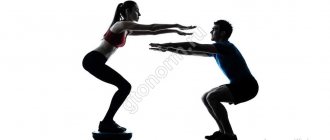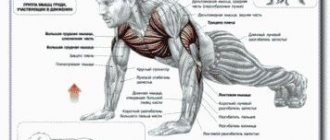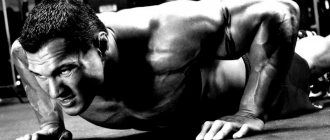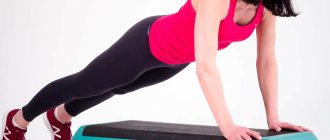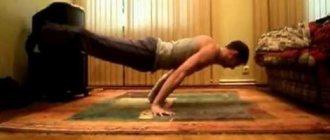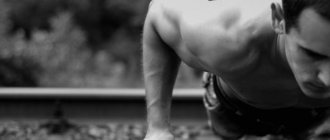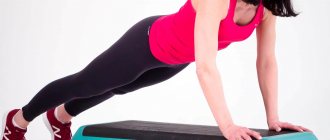Push-ups are one of the main exercises for pumping up the muscles of the upper body. Despite its simplicity, it is very effective, allowing us to get strong arms, a strong back and sculpted abs. Push-ups also help strengthen the heart and blood vessels, warm up the muscles and prepare them for more serious stress. To achieve good results with this exercise, you need to master its correct technique. But that is not all. It is important to know how to breathe correctly when doing push-ups. Many people believe that breathing is secondary in this matter and are seriously mistaken. Breathing technique directly affects the benefits and effectiveness of the exercise. Air retention leads to a lack of oxygen, and this in turn causes disruption of the heart and the lack of the desired result. But first things first. Let's take a closer look at what breathing should be like when doing push-ups.
Breathing technique during push-ups
Breathing when doing push-ups should be as follows:
- Starting position - lying on your palms and feet, arms slightly wider than shoulders
- Bend your elbows and gently lower yourself down while taking a deep breath through your nose.
- Having reached the bottom position and lightly touching the floor with your chest, begin to move upward. Simultaneously with raising your torso, begin to exhale through your mouth.
- The exhalation power should increase, reaching its peak at the top point, synchronously with the extension of the arms.
Recommendations for push-ups
- Having chosen this exercise for yourself, make sure that your back is always straight, your lower back does not sag, and muscles that are not involved in the exercise do not tense.
- You don’t need to do a lot of push-ups at once, but divide them into approaches, then the effect will be maximum. To begin with, it will be enough to perform three sets of ten times.
- You need to first increase the number of push-ups, then the number of approaches.
- You should not abuse the increase in the number of push-ups; this is rational if your goal is to build endurance. If you want to pump up your muscles, then it is better to use weights and more complex techniques, for example, push-ups on your fists or with your legs thrown back on a hill.
Doing push-ups correctly is great, but doing push-ups using proper breathing technique is even better. The result of the training and the state of your health after it will depend on how much you can implement it in practice.
Common mistakes in breathing techniques
Breathing during push-ups is a simple, physiological process.
However, many people make various mistakes here:
- Confusing inhalation and exhalation
This leads to disruption of the breathing rhythm and premature termination of the exercise.
When lowering down, the chest expands and a natural deep breath occurs. When going up, the chest narrows. Exhale physiologically.
- Holding your breath (straining)
When performing forceful movements, straining can provoke an increase in blood pressure. Breathe evenly, without delay.
- Complete cessation of breathing
This is a gross mistake that quickly leads to the inability to perform the exercise.
- Breathing during push-ups only through the nose or only through the mouth
This is not a serious technical error, but the “inhale through the nose, exhale through the mouth” cycle allows you to perform the movement more effectively.
Advantages of the classic exercise with emphasis on the floor
Regularly performing push-ups leads to:
- development of body hardening;
- strengthening ligaments and tendons;
- increasing vital activity;
- improving metabolism.
An important advantage of the exercises is the possibility of modifying the task, which allows you to train different areas of the muscles. There are lightweight options that are suitable for untrained people, and further complication of push-ups itself is an endless process. Pull-ups and squats, and some types of push-ups allow you to:
- improve muscle coordination;
- improve the nervous system;
- develop reaction speed.
The benefits and effectiveness of the exercise are directly related to breathing technique, as proven by Dr. Bubnovsky. If air is retained, the work of the heart muscle will be disrupted, and neither women nor men will achieve the desired result.
Why you shouldn't hold your breath
Power push-ups (such as using weights or if you're just learning to do push-ups) help develop muscle mass and strength.
This happens if you have difficulty doing 10-15 repetitions per set.
BRIEFLY ON THE TOPIC:
When performing strength exercises, it is strictly forbidden to hold your breath or strain. This can increase blood pressure, and in the worst case, it can lead to fainting.
If you can do more than 20 push-ups, then your training will already be aimed at developing strength endurance.
When you hold your breath during exercise, the rhythm of the movement is disrupted, which significantly reduces the number of repetitions and the effectiveness of the exercise.
What happens to the body during push-ups?
Whatever type of push-ups you perform, there is a load on all the muscles of the shoulder girdle. The main part of it falls on the pectoral muscles, anterior deltoids and triceps. The abdominal muscles, spinal extensors and buttocks are in a state of static tension.
When lowering the body down, the muscles stretch, and when lifting, they contract. In this case, it is important to keep your back straight, not to round the cervical spine, not to raise your buttocks above the level of your lower back and, of course, to monitor your breathing rate. Only then will you achieve the correct technique for performing push-ups, which will help you:
- Quickly tone almost all muscle groups of the upper body.
- Perform more repetitions.
- Get faster results than when doing it with incorrect technique and breathing.
- Reduce the risk of injury.
Contraindications for performing push-ups
Push-ups are a low-impact movement.
However, even it has contraindications:
- Injuries and diseases of the shoulder, elbow joints and hands (bursitis, tenditis, arthrosis, etc.)
- Injuries to muscles and ligaments involved in movement
- Diseases and injuries of the spine
- Tendency to increase blood pressure. Strength training in this case can raise it, so you need to listen to your feelings.
Push-ups in 6 weeks: how can girls learn to do push-ups?
It will be more difficult for the fair sex to master push-ups from scratch than for men. As a rule, due to natural features, they require a little more time.
httpv://www.youtube.com/watch?v=embed/aAh8XmiwV4g
And, as practice shows, almost all girls start with lead-up exercises, since no one can do more than five push-ups (and usually 2-3 times). And to strengthen your arms and torso, start with easier exercises.
First, these are push-ups from the wall, then from a bench or chair, and then on your knees. As soon as you can do 15-20 repetitions in each of these exercises, then move on to the next one.
After mastering them, it is recommended to move on to the classics and regular training. For girls, effective push-up training in 6 weeks is a reality! But it’s worth noting right away that it will take persistence and effort.
How to train girls? Let's look at the table in more detail:
| A week | 1st | 2nd | 3rd | 4th | 5th | 6th |
| Number of workouts per week | 3 times | 3 times | 3 times | 3-4 times | 4 times | 4-5 times |
| Number of approaches and repetitions | 3*max | 3*10-12 | 4*10-12 | 4*12-15 | 4*15 | 4-5*15 |
| Rest time between sets | 2 minutes | 2 minutes | 1.5-2 min | 1.5 min | 1.5 min | 1-1.5 min |
Again, this scheme is not a standard. This is just a base, a template that you can focus on and adjust the load to suit you. To some it may seem complicated, but to others it may seem easy. To do this, simply add or subtract the number of sets or repetitions.
Breathing while resting between squats
When a person trains, special attention should be paid to breathing during rest.
Otherwise, the trainee:
- will not be able to fully recover between sets of squats;
- his heart rate will not have time to normalize;
- there will be additional stress on the lungs and vascular system;
- gets tired quickly;
- may lose consciousness during the next series of squats.
To prevent all negative consequences during rest, it is recommended:
- Inhale and exit exclusively through your nose.
- When inhaling, try to get as much oxygen as possible into the lungs.
- Exit should be done smoothly and until the chest is cleared of oxygen.
In addition, during rest it is extremely important:
- sit quietly for 1 to 6 minutes and breathe correctly through your nose;
- breathe at the same pace without faltering;
- do not hold anything in your hands and, if possible, remove your shoes.
It is most effective to relax in the fresh air or near an open window. With this option, oxygen saturation of all organs and tissues occurs twice as fast.
Experienced trainers advise not to spend more than six minutes resting between a series of squats, however, if a person feels that during this time his pulse has not leveled out, then it is permissible to extend the pause in the lesson.
In the case when a person cannot restore his breathing for more than 8–10 minutes, this indicates that the physical activity for him at the moment is unbearable. It is recommended to reduce the time or complexity of the workout.
Muscle load
Push-ups are aimed at training the arms and upper body:
- biceps,
- triceps,
- pectoral muscle,
- serratus anterior muscles,
- deltoid muscles,
- back muscles.
1
Chest muscles
To maximize the use of your pectoral muscles in push-ups, you need to spread your arms wide. By performing the exercise in this way, we force the chest muscles to perform their main task - bringing the arms together.
The arms are spread wide, the body is straight.
In classic push-ups, with your arms and legs on the floor, the middle and bottom of your chest are worked. If your feet are on a low bench, then the upper chest will be involved. You should not place your feet too high so that the load does not fall on your shoulders.
These push-ups primarily work the upper chest.
Triceps
Triceps work with any push-up. To maximize their use, you need to minimize the work of the chest muscles. To do this, place your palms shoulder-width apart and keep your elbows close to your body. This will give you push-ups with a narrow arm position and a good load on your triceps.
Hands are shoulder-width apart or narrower, elbows are bent in the same plane as the body.
Deltoid
You can direct the load on your shoulders during push-ups by placing your feet on a high bench. You can increase the load by raising your pelvis. This way you will work out the front and middle bundles of the deltoid muscles as much as possible.
1
These push-ups should be performed when the pectoral muscles and triceps are sufficiently trained.
The important role of breathing
During the process of respiration, nutrients are broken down and energy is generated. To do this, the body needs oxygen, which is supplied to the lungs during this process. Optimal oxygenation of the lungs is the main goal of this process.
If enough oxygen is supplied, then more energy is produced in the muscles and fewer harmful breakdown products.
But if the body lacks oxygen, then physical activity will be ineffective, and a lot of lactic acid will accumulate in the muscles.
How to breathe correctly during lunges with a barbell
The breathing technique for squats with a barbell is slightly different from that given above:
- Take the starting position;
- The barbell is placed on the shoulders, the back is kept straight, the legs are slightly apart;
- Fill your lungs halfway with oxygen and begin to squat slowly while continuing to inhale;
- If you need to fix the position, stop breathing for these few seconds;
- As you ascend, begin to exhale smoothly, but do not try to completely empty your lungs, so as not to increase the load. You can exhale the remaining carbon dioxide when you complete the lift - the most important thing is to lift the set weight.
As you can see, in classic lunges you are allowed to exhale sharply, thereby speeding up the rise. This option is more suitable for aerobic exercise. But during strength training you should not rush, on the contrary, act smoothly and slowly. So, if you're wondering how to breathe while doing squats for weight loss, we recommend sticking with the classic lunge technique, although it works great with the front variation.
Morning or evening: when is it better to do push-ups?
It all depends on what goals are set. If you use push-ups as a warm-up, it is better to do push-ups in the morning. But for pumping muscles, the best time for push-ups is in the evening.
It is worth remembering that in order to achieve strength progress, it is necessary to give muscle fibers rest so that they recover. But to maintain muscle tone and prevent diseases, you can do it every day.
Is it possible to do push-ups before bed?
Naturally, everything is very individual. Some people quickly fall asleep after physical activity in a sweet and sound sleep. But on average, physical activity is not recommended 2-3 hours before bedtime.
The fact is that this will excite the central nervous system and even with a strong desire to sleep, it will be very difficult and difficult to fall asleep. So try not to exercise before bed.
The body, being in an excited state, must “cool down” for some time in order for the functioning of all systems to normalize. So it is not recommended to do push-ups at night.
Is it possible to do push-ups after eating?
Physical activity is strictly prohibited on a full stomach. After all, at this moment all the body’s forces and blood are aimed at processing food. If you start training at this moment, you can greatly disrupt the digestion process.
And in the future, this may negatively affect your health. Therefore, physical activity is allowed only 1-1.5 hours after eating.
Push-ups in the morning
Is it possible to do push-ups in the morning after sleep? If as a warm-up, then this is one of the best solutions! Physical activity combined with a glass of water will help you wake up quickly and energize you for the whole day. The most important thing is that you don’t have to be overzealous.
To increase muscle tone and vigor, up to 50 push-ups are enough, which can be divided into 2-3 approaches. For girls, 20-25 repetitions will be enough.
You can exercise on an empty stomach, but it is still recommended to drink water before doing so. Training on an empty stomach will not provide any practical benefit in increasing strength and building muscle. Therefore, emphasis should be placed on the minimum number of approaches and repetitions.
A little about the anatomy of breathing
The best way to learn information about proper breathing is to understand how it all works from a physiological point of view. Knowing the whole process, it will be easier to set yourself up for good and productive work:
- During the exercises, you need to breathe exclusively through your nose, and you can only use your mouth to exhale. The fact is that the mucous membrane of the respiratory tract contains a set of receptors that signal to the brain to receive oxygen. Therefore, if you breathe first through your mouth, then through your nose and alternate this process, you can confuse your brain.
- The average lung volume of an adult is 6 liters. But, the maximum amount of air when inhaling is 2 liters. There is no need to try to take as deep a breath as possible at the beginning of the exercise. Such an attempt can lead to an uneven supply of oxygen to the tissues, which in turn will cause loss of consciousness.
- Before performing an exercise, in particular squats, it is important not only to stretch the muscles, ligaments and joints, but also to prepare the respiratory system for work. Therefore, during warm-up, you can use breathing exercises to ventilate your lungs. This approach will improve strength and endurance.
How many push-ups do you need to do to become strong?
A fairly common and relevant question. But it will not be possible to answer it in detail. Why?
- First, what does it mean to be strong enough? For everyone, this concept is revealed in its own way.
- Secondly, push-ups are not an exercise in which you can achieve impressive strength results.
Therefore, you should not focus on push-ups when it comes to strength indicators. Yes, you will become a little (or maybe even a lot, compared to your original state) stronger, but, alas, you won’t be able to set any records. Muscles need a varied load, which cannot be achieved with push-ups alone.
Exhale correctly
The process of exhalation and the accompanying contraction of the lateral and abdominal muscles will add additional rigidity to your body, stabilize it and help tighten all the necessary muscles. An experienced athlete, without hesitation, uses proper breathing to his advantage while performing push-ups from parallel bars, from a wall or from the floor.
During impact push-ups from the floor, when the count goes even for one additional repetition, which ultimately contributes to an increase in the result, exhalation activates the release of additional adrenaline into the blood so that the body can cope with the critical load.
In addition, an athlete distorted by a grimace during such a shock press from the floor or from the uneven bars simply physically will not be able to inhale, since the body will reflexively react by relaxing and disorienting him.
Why is breathing correctly so important?
During inhalation, oxygen enters the lungs, which, together with the blood, is carried to every cell of our body, including the brain. Hypoxia or oxygen starvation during periods of intense physical activity is severe stress for the body, which can result in loss of consciousness.
Every athlete should know how to breathe correctly during squats, both without a barbell and with additional weight, at all stages of the exercise. By the way, the basis of correct breathing technique is based on the main rule - exhalation is done at maximum effort, and inhalation is done at the stage preceding it. That is, if we talk about squats, exhale while lifting, and inhale, respectively, while squatting.
You need to breathe smoothly, without jerking, try to maintain a uniform pace and depth of breaths. Otherwise, the load on the heart increases sharply, arrhythmia may develop, and blood pressure may rise. Remember this no matter what exercise you choose: Bulgarian split squats or hack exercises.
How to breathe correctly according to Bubnovsky
The author of the best-selling book “50 Essential Exercises for Health” included squats in the list of basic exercises for maintaining good health and excellent physical shape. He developed his own breathing technique, which, in his opinion, has the greatest positive effect. So, how to breathe correctly when doing squats according to Bubnovsky, let’s find out what the point is:
- Squat while inhaling, stand up while exhaling;
- At the same time, during exhalation you need to loudly pronounce “Ha a”;
- Exhale sharply, clearly and rhythmically. At the moment of pronouncing the last “a”, the lungs should be completely empty, and the body should return to its original position.
That's the simple technique - try it, many athletes who practice it really notice the benefits.
When to watch your breathing
Contrary to popular belief, breathing movements need to be monitored from the very beginning of training.
Proper breathing is an important step in the sports life of any athlete.
But we must not forget about technique and experienced athletes. Breath control should be an integral part of any workout at any time. Over time, this will develop into automaticity, but in any case, you will need to check yourself periodically to do it correctly.
What are the benefits of push-ups?
Many people neglect this exercise because they consider it not effective enough.
However, with a well-designed training program, push-ups have the following advantages:
- Helps strengthen the circulatory system and heart;
- Increases the overall tone of the body;
- Helps increase strength and endurance;
- Develops the muscles of the shoulders, triceps and chest;
- Loads the buttocks and abs;
- Form the habit of active sports;
- Makes the body more resilient;
- They speed up metabolism, which in combination with a balanced diet allows you to achieve a good figure;
- Useful for those who practice various types of martial arts;
- Representatives of the fair sex are helped to tighten their bust and make it slimmer.
It is also worth noting that push-ups, according to research, have proven to be an excellent tool in the prevention of diseases such as bursitis and arthritis. If you start exercising at an early stage, performing at least 80 push-ups every day, then within a month you will notice a general improvement in your well-being, as well as a lack of pain in the joints.
In principle, like any physical activity, push-ups are useful in the early stages for people who have certain joint problems
However, it is very important to consult with relevant specialists so as not to harm yourself.

